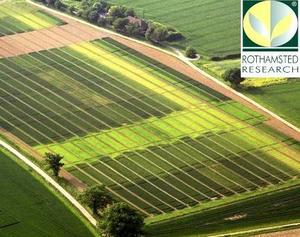Europe
May 14, 2014

Field experiments and sampling of soil and plants started at Rothamsted in the 19th century and continue to provide data relevant to crop protection today, reports Sarah Perryman. She writes: The electronic Rothamsted Archive (e-RA) is a unique internet resource providing access to data from the oldest continuous agronomic experiments in the world and can be used in forecasting diseases and understanding changes in weed flora, disease spectra, pathogen resistance to fungicides and virulence.
The story goes back to the period between 1843 and 1856 when Sir John Bennet Lawes and Sir Joseph Henry Gilbert established several field experiments on Lawes’s Rothamsted estate in Harpenden, south-east England. Some of these experiments continue today, more or less as originally planned, and e-RA brings data from these experiments, together with associated meteorological records and accompanying documentation, into a database which users can query. e-RA provides easy access to experimental data and specialist background information on the effects of agricultural practices on crops, soils and associated ecosystems and is available to scientists around the world.
The current version of e-RA holds records of crop yields and other data (including weeds, diseases, species composition and soil, plus experimental information on cropping and treatments) for four of these long-term 'classical experiments': the Broadbalk wheat experiment (since 1843), the Park Grass continuous hay experiment (since 1856), Hoosfield spring barley (since 1852) and the alternate wheat and fallow experiment (since 1856).
Data is continually being added and in future will include other information such as crop nutrient content. The long-term data is not confined to the field experiments as meteorological data from Rothamsted (Hertfordshire), Brooms Barn (Suffolk) and Woburn (Bedfordshire) is also available, with Rothamsted’s meteorological being one of the longest running datasets in the world (rainfall from 1853 and temperature from 1878). A comprehensive searchable bibliography relating to the long-term experiments is also available.
To simplify access to commonly requested datasets, a selection of pre-prepared records are freely available and can be downloaded from the e-RA website, together with useful graphs and charts. These datasets include the mean long-term winter wheat yields from selected treatments on Broadbalk - referred to in numerous publications - and Park Grass species diversity. Future plans include the provision of additional subsets of weather data, specifically for schools and universities, and the inclusion of other commonly requested datasets for the classical experiments.
In addition to the experiments, the associated Rothamsted sample archive holds around 300,000 air-dried soil and plant samples collected since the experiments began. The experiments, sample archive and e-RA have proved to be of value to many scientific disciplines, including soil and climate modelling, biodiversity and agro-ecology, crop nutrition and production, plant pathology and physiology. Specific examples include:
Mathematical models and forecasting: Carbon storage and the development and calibration of mathematical models such as the RothC model of the carbon cycle, which is used by more than 1,650 scientists in 95 countries. The meteorological data has been used as the driver for many crop and ecosystem models, and is invaluable in understanding and forecasting crop diseases, such as the light leaf spot forecasts.
Environmental and biological trends: Changes in weed flora in response to agricultural intensification: for example, analysis of Broadbalk long-term weed survey data confirmed that as nitrogen inputs increased, the relative abundance of different weed functional groups changed. An understanding of the response traits of arable plants to different management options is valuable for predicting future shifts in the functional diversity of weed communities including the potential for invasive species to establish.
Changes in disease spectra of crops: In 2005, scientists extracted the DNA of two wheat pathogens from archived samples dating back to 1844 and showed that industrial sulphur dioxide emissions differentially affected pathogens. During 1890–1980, Phaeosphaeria nodorum was most prominent, whereas pre-1890 and post-1980 Mycosphaerella graminicola was more dominant. These observations were not explained by weather or agronomy, but did correlate well with changes in atmospheric sulphur dioxide emissions. DNA analyses of 160 years of archived potato samples showed how disease pathogens survived between cropping seasons, and the same pathogen (Phytophthora infestans ) was shown to be responsible for both the 1840 and 1870 outbreaks of potato blight. This long -term series of potato samples has provided a better understanding of late potato blight and the implications for today’s food security.
Evolution of traits such as fungicide resistance and virulence in pathogen populations: Analysis of historical barley leaf samples from 1892 to 2008 showed how past evolutionary changes involving multiple paralogues of the azole target protein sterol 14?-demethylase (CYP51) were related to a shift in fungicide sensitivity from the mid-1980s. Results indicated that the majority of the Rhynchosporium commune population before 1985 lacked the CYP51A gene. Resistance to pesticides is a challenge in agriculture and understanding the evolutionary mechanism involved in the emergence and spread of resistance can aid risk assessment and management.
To date e-RA users include scientists from global research institutes such as the World Vegetable Research Centre in Taiwan, CSIRO Australia, Plant and Food Research, New Zealand, universities in the USA (including Cornell, Ohio State, Yale, Michigan and Kansas State), ENDURE partners such as Denmark's Aarhus University and the UK's James Hutton Institute, UK universities (including Imperial, Exeter, Aberdeen, Reading, Oxford, UEA, Brunel, Swansea and Lancaster) and companies such as Affinity Water. Data is also made available to universities and schools for teaching purposes.
Funded by the UK's Biotechnology and Biological Sciences Research Council and the Lawes Agriculutural Trust, e-RA, Rothamsted's long-term experiments, sample archive and meteorological data are part of the UK's Long-Term Experiments National Capability and linked to similar experiments and research platforms around the world via the Long-Term Soil-Ecosystem Experiments Global Inventory and the European Union-funded Distributed Infrastructure for EXPErimentation in Ecosystem Research.
For further information on obtaining e-RA data, registration and a password contact Dr Margaret Glendining or Dr Sarah Perryman. To visit the e-RA website, click here.